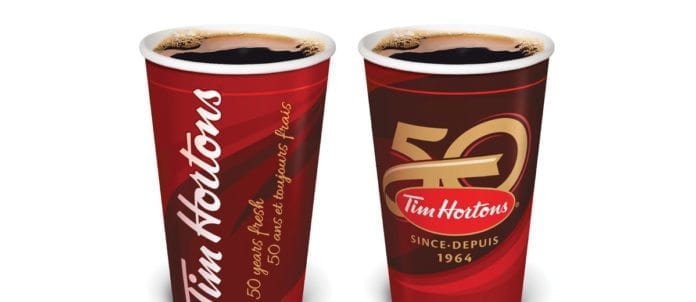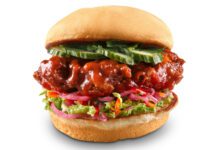In a world where consumer loyalty can often be bought with a coupon, one brand maintains an enviable hold on the hearts of Canadians. Indeed, when General Rick Hillier asked soldiers stationed in The Gulf what they would most like from home, they asked for Tim Hortons coffee.
Small wonder then, that it’s been called a Canadian institution. From garage attendants to Bay street brokers, Tim Hortons customers represent a microcosm of Canadian society at every level.
In the business towers of busy cities, the distinctive brown and red cups and logoed bags are a common sight in elevators. Joggers, seniors out for a healthy constitutional, and moms who have just dropped the kids to school stop in for a breakfast sandwich. At drive-thru locations across the country, truckers, farmers and travellers pick up coffee and a snack. And employees at factories and hospitals, students at universities and colleges, and passengers at bustling airports grab a cup of their favourite beverage en route.
Astoundingly, 75 per cent of the coffee served at Canadian quick-service restaurants (QSR) is served at Tim Hortons, according to The NPD Group/CREST, year-ending February 2014. And the term ‘Double Double’ is now so commonplace in the Canadian lexicon that it has been included in the Canadian Oxford Dictionary.
“Coffee is somewhat of a habitual experience and 15 per cent of Canadians come to Tims at least once a day; some guests even come multiple times a day,” says Roland Walton, president of Tim Hortons Canada. “Because of that, we get to know them and establish relationships with them.” He offers an example: “I worked at a Timmys drive-thru one day — I try to do that every so often — and I was amazed to find that the young lady working with me knew the guest by the sound of his truck. And she knew his order.” He adds: “Building relationships with customers is what makes working at Tim Hortons a little different and really satisfying.”
Equally important are the relationships Tims customers build with the brand. Indeed, there are few quick-service brands that can claim the same degree of customer loyalty and community support — and fewer still whose customers are likely to ask for team members by name.
Recognizing the value of this relationship, the company’s True Stories ad campaign, running since 1996, has capitalized on this strength. Based on real events, these mini-sagas tug at our collective heartstrings. Indeed, one of these stories documented Gulf War soldiers enjoying their first taste of home in a foreign land. And a recent one shows an African immigrant at the airport picking up his wife and children who have come to join him in their new home. He brings her a warm coat and a cup of Tims coffee, and says, “Welcome to Canada.”
“The True Stories campaign has never won an award, but it makes a difference to our brand perception,” says Bill Moir, chief brand and marketing officer for Tim Hortons. “It speaks to our values, which are consistent with Canadian values, and that partly explains why we have been successful.”
Indeed, Tim Hortons is often referred to as a Canadian icon. But, Moir cautions, “We’re careful not to call ourselves that. It’s very flattering, but you can’t get too full of yourself. Every day we have to get better and deliver on the promise.”
Tim Hortons has been making that delivery for 50 years, building 4,485 restaurants in Canada, the U.S. and The Gulf Cooperation Council, with another 800 planned in the next five years. The company accrued $6.7 billion in gross sales in 2013, increasing by $331 million year over year and earning the Tops in Hospitality award for greatest dollar increase on F&H’s 2014 Top 100 Report.
From 1995 to 2006, the company was owned by Dublin, Ohio-based Wendy’s International Inc. At the time, many Canadians were distressed to find ‘their Timmys’ had changed hands, and rejoiced when ownership shifted back to Oakville, Ont.-based TDL Group Corp.
Coffee and Doughnuts
The chain that began with coffee and doughnuts in 1964 has consistently worked at finding its way into niches that its founder, NHL hockey great Tim Horton, and his business partner, Ron Joyce, probably never considered in the early days.
Joyce was the franchisee of the first restaurant in Hamilton, Ont.; by 1967, the pair had become partners. In the early days, it wasn’t unusual for Horton to take his hockey buddies to the store to sign autographs — smart marketing that attracted customers. Back then, policemen, ambulance drivers and firemen often got free coffee, a fine way to say thank you to the citizens who worked to keep their communities safe. It was the start of a relationship with the local community and a commitment to civic responsibility that was to become an important part of the brand.
Tim Hortons’ earliest customers were predominantly males who enjoyed a cigarette with their coffee and doughnuts. That demographic — and its addiction — has changed. Nonetheless, it’s probably indicative of the enduring loyalty of customers that the most popular doughnuts back then were the apple fritter and the Dutchie, which still remain top sellers.
Muffins were added later, along with other baked goods, but it was the launch of bagels in 1996 that completely changed the landscape. Seeing the popularity of New York-style bagels, the company worked with Canada Bread to bring a slightly softer version to market. “Bagels were the first product we offered that we had to prepare for the customer,” says Moir. “We had to bring in new equipment — bagel toasters; we had to develop the operational side, and we had to train the staff to handle it quickly and efficiently. After all, we didn’t want longer lineups while people waited.”
It proved to be a watershed. In the first half of 1996, sales were soft, but the bagel turned the company around. Not only did it attract more female customers, but the chain discovered it could gear up and add another layer to service. “We could take products and ‘mainstream’ them,” says Moir. “It was the first step to adding more prepared foods.” And it was the beginning of the can-do attitude that continues to inform business decisions today.
By the late ’90s, “fresh” had become a mantra, and “freshly prepared” became part of the Tims’ ethos. So, when David Clanachan, COO of Tim Hortons, observed an interesting phenomenon in boulangeries (bakeries) in France, he was impressed. Struggling to find staff to bake fresh bread in the middle of the night, these shops were turning to par-baking. It wasn’t long before Tim Hortons, too, was offering its customers baked goods straight from the oven.
“Par-baking allowed us to provide fresh product on demand, nearer the time people wanted to buy it,” says Clanachan. “Today we’re baking closer and closer to the time of sale than ever before. You’ll even hear team members say, ‘We’re just baking the crullers. Have a cup of coffee; they’ll be ready in a minute.’ That’s really fresh, and customers appreciate it.” The idea is to bake small amounts more often, leading to better control over the product, greater consistency and, most importantly, a fresher product. As a bonus, waste decreased significantly.
Beyond Coffee and Doughnuts
Keeping ahead of the competition requires foresight. “You have to stay in touch with what’s going on in the marketplace around the world — be aware of what’s in the early breaking stage,” says Walton. “We may not be first in, but we’re very close to the beginning, and we do it well.”
The education that began with bagels taught chain executives they could tackle other products and put their unique stamp on them. “We call it ‘differentiated innovation.’ We do it the Tims’ way. First, we run it through a number of filters: how will our guests respond to this product? Then there’s equipment, research and development, and, of course, we have to get our owners onside. It’s important that when we say, ‘Everybody put your oars in the water and row,’ that we’re all doing it in unison,” says Clanachan. “We strive for flawless execution. People are often amazed at the consistency of delivery at Tims.”
This approach has enabled the company to successfully introduce a range of menu items that cover every daypart — from the Flatbread Breakfast Panini to the Tuscan Chicken Panini, the Hearty Potato Bacon soup and the Iced Chocolate Latte. Indeed, the best indicator of trends in quick-service dining is probably the Tim Hortons menu.
Often, Tims has become the dominant player in each market — sometimes despite research indicating that a product will not succeed. “When we researched soups, people would tell us, ‘I don’t think that will fit in with my Tims…. But if Henry Ford had asked customers what they wanted, they’d have replied, ‘Faster horses,’” laughs Clanachan. “If we had listened to the research, we would never have served soup. Today we sell more soup than any other restaurant company in North America.”
Soup is not the only product that has proven remarkably successful. Bagels remain a top seller, and 90 per cent of the bagels ordered at Canadian QSRs are served at Tims, according to The NPD Group/CREST, year-ending February 2014. But not every new item succeeded the first time — a notable example is cinnamon buns, which were withdrawn and re-introduced with greater success more recently. Perhaps the most extraordinary example of how successfully the chain can bring products to market is the breakfast sandwich. Although developed and made famous by another company, Tims has the number-1 share of breakfast sandwich servings in Canada today, according to The NPD Group/CREST, year-ending February 2014. Perhaps, Clanachan suggests, because Canadians are already there to buy their coffee in the morning.
It all started with coffee but, in 1999, Iced Cappuccino (fondly known as the Ice Cap) was introduced to offer guests a cool alternative in hot weather. According to NPD CREST data, last year nearly nine out of 10 cups of QSR frozen slush coffee beverages sold in Canada were prepared at Tims.
Having mastered the coffee market, the company turned its attention to tea. In 2004, it introduced steeped tea, garnering praise and gratitude from Canada’s tea drinkers. “No one was doing tea properly in QSR,” says Clanachan. “Today, three out of four cups of tea are bought at Tims.”
The newest beverage roll-outs beginning south of the border are iced dark roast coffee and frozen hot chocolate. “A couple of others have tried the chocolate, but we have a different twist on it,” says Mike Meilleur, EVP, Tim Hortons U.S.A. “It’s going to be a great product for us on both sides of the border.”
Keeping the Success Rolling
It’s impossible to mention Tim Hortons’ beverages without alluding to one of the most successful marketing programs ever conceived in Canada — Tim Hortons’ Roll Up the Rim. For about 10 weeks each spring, customers enthusiastically roll the rims up on 280-million Tim Hortons cups for the chance to win one of six prizes, ranging from a cup of coffee or a doughnut to a car. While executives won’t divulge sales increases during what has become an annual Canadian spring tradition, it’s not insignificant that one of their major competitors chooses the same time period to offer its coffee for $1.
Despite this catalogue of successes, Tim Hortons isn’t resting on its laurels. “The challenge over the next 50 years is to continue to lead, defend and grow,” says Walton. “We need to set the pace. We need to be the people driving the change whether in menu or technology innovation.”
One technology innovation has been a recently announced partnership between Tim Hortons and Cineplex Digital Networks to launch TimsTV, one of the largest digital programming networks in the Canadian restaurant and retail sectors. The in-restaurant television channel will showcase Tim Hortons’ content (for which details were not available at press time), broadcasting to 2,200 Tims restaurants in a creative, informative and entertaining manner with Cineplex ads interspersed within.
“This is a very competitive field,” acknowledges Walton. “When you’re top dog, people come after you, so we have to defend what we have. And we have to keep the pace.”





















